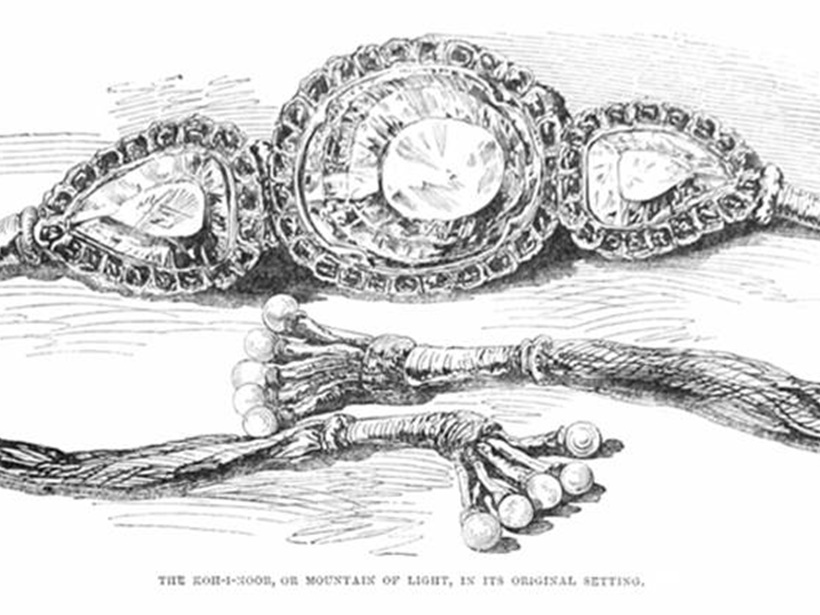Can you guess what these historical figures have in common?

By Archana Garodia Gupta and Shruti Garodia
Can you guess how these four men are connected?
Clue 1: It is one of the most famous and valuable objects from India
Clue 2: It is not in India
Clue 3: It has never been bought or sold, only gifted, bartered or stolen!


These four men seem poles apart, with little in common. Yet they were all connected through the most famous gemstone in the world—the Kohinoor diamond.
The massive 186-carat (37gm) gemstone probably came from Golconda, known for its fine diamonds. A 12th century ancient Indian script speaks of a curse on it, “He who owns this diamond will own the world, but will also know all its misfortunes. Only God, or a woman, can wear it freely”.
Also Read: Quaint Math puzzles from ancient India
Over the centuries, the magnificent diamond was elusive, appearing on and off in descriptions of various kings’ treasures until it finally came to the Mughal emperors, who ruled over most of India.
After Aurangzeb’s death, in 1707, the Mughal Empire went downhill steeply. In 1739, the mad military genius Nadir Shah swept in from Persia to raid India. The inept Mughal emperor, Mohammad Shah ‘Rangeela’, was busy making merry and barely stirred as the brutally efficient Persian military machine rolled into Delhi. When Nadir Shah was done stripping Delhi of her vast riches and about to leave with treasure laden on 700 elephants, 4,000 camels and 12,000 horses, he got wind that Emperor Mohammad Shah had squirrelled away a fabulous 186-carat diamond in the folds of his royal turban! On his way out, Nadir Shah ‘gently’ insisted that the two kings exchange turbans to show ‘friendship’. When he finally saw the magnificent diamond, he apparently exclaimed “koh-i-noor!”, meaning ‘mountain of light’.


So India’s most famous jewel was named by one of her most infamous raiders!
Back in Persia, Nader Shah went nuts in a few years and was killed off by his own soldiers. In the ensuing chaos, one of his Afghan generals carried off the Kohinoor back home, where he became the first king of Afghanistan, Ahmad Shah Abdali.
Nearly 75 years later, when Abdali’s descendant, King Shah Shuja Durrani was being ‘entertained’ (that is, being gently held prisoner) at the Sikh Maharaja Ranjit Singh’s court at Lahore in 1813, he was ‘persuaded’ to hand over the Kohinoor!
By now, the British East India Company was flexing their muscle throughout India, but never messed around with Ranjit Singh, and regularly came to Lahore to pay their respects. They describe that he “sat there dressed all in white, wearing pearls around the waist, and the Kohinoor mounted on an armband.” Of course, as soon as Ranjit Singh died, they began snapping at the heels of the short-lived Sikh Empire and within 10 years, along with the Punjab, took the by-now mythical Kohinoor as spoils of war to hand over to their Queen Victoria.
Well, almost. A British official called John Lawrence tucked the Kohinoor away in his waistcoat, which was sent off for laundry! After some major panic, his valet returned ‘the large bit of glass’ to a very relieved Lawrence (who would later become Viceroy of India!), after which it was guarded most ferociously until being handed over to the Queen of England in 1850.
Victoria took the diamond’s curse seriously, and her will commanded that the Kohinoor could only be worn by a woman. And indeed, after her, it has only been worn by Queen Alexandra (wife of King Edward VII), Queen Mary and Queen Elizabeth!
The Kohinoor was proudly displayed at the Great Exhibition of 1851 in London, which was the brainchild of the Queen’s husband, Prince Albert.
Sadly, the British public were underwhelmed at what looked like “common glass”. Albert took this very personally and had the Kohinoor recut to increase its brilliance and shine, reducing its size by almost 40 per cent to just 106 carats!
Queen Victoria wore it as a brooch, after which it was transferred from one British crown to another, where it remains, despite the periodic ruckus Indians raise to have it returned!
(For more fun journeys through India’s history, check out the newly released two-volume set, The History of India for Children Vol. 1 and Vol. 2, published by Hachette India, which is now available online and in bookstores across the country.)
Source: Read Full Article




